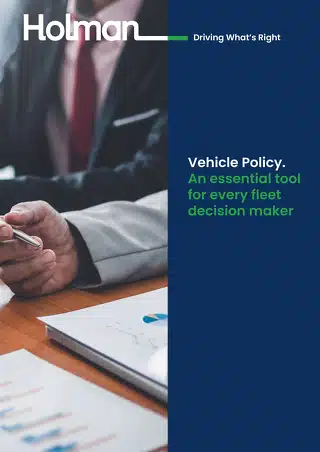-
What We DoFrom fleet management and productivity solutions to upfitting, fabrication, and insurance, Holman has the integrated automotive services expertise to keep your business moving.Overview
-
ResourcesWe have a lot to share. Browse our resources library for current insights, data, strategies, and success stories from our own experts in their respective fields.Overview
-
About UsWhen Holman was founded in 1924, we set something positive in motion. Our consistent focus on people and our commitment to integrity make us who we are today.Overview
 Join Our TeamWe’re not just in the automotive business, we’re in the people business. Join us for the ride.Browse Careers
Join Our TeamWe’re not just in the automotive business, we’re in the people business. Join us for the ride.Browse Careers
5 Tips To Futureproof Your Vehicle
Holman Marketing
October 17th, 2022

Your vehicle policy is a crucial document that every employee should know inside and out. In it, you’ll find who is eligible for a fleet vehicle, how it should be driven and the regulations covering its usage. But it’s more than a simple set of rules. By setting out a clear vision for vehicle use, you can set expectations and create a positive culture of vehicle use among all employees.
You can go online and download a cookie-cutter vehicle policy template, but trust us, this won’t apply to your (or any) business. Instead, you should invest time developing a policy with stakeholders that’s relevant and realistic.
Up-to-date vehicle policies ensure that procedures surrounding all aspects of vehicle use are clearly outlined for all levels within your business. A well-written policy can help maximise efficiency, improve safety and impact your sustainability goals.
Here are five practical ways you can futureproof your vehicle policy.
1. Engage stakeholders early
Your policy is about people who qualify for a vehicle, what vehicle they get and how they should drive it. Too often, we create policies in silos, forgetting that they will be interpreted and implemented by real people, who may interpret the same messages differently.
Organisations should engage all stakeholders who will be affected by the policy. This doesn’t mean asking everyone’s opinion but providing opportunities for feedback and representation. For example, focus groups, online surveys, or the chance to raise issues in regular meetings can provide essential insights that can help improve your policy and increase adherence.
The result is a policy that staff and stakeholders feel invested in and are less likely to ignore or break.
2. Tick every box and test every scenario
Your vehicle policy must be rock-solid, so ensure you’ve ticked every box and tested every scenario. Organisations should conduct research and engage with subject matter experts to confirm the feasibility and impact of all proposed policy statements. Your policy will impact internal teams, including HR, finance, sales and more – so ensure they’re part of this process.
Work methodically and test scenarios to understand how your policy will work in the real world. User-testing can help you identify any issues, errors or inconsistencies that could be present in your policy and iron them out before they come back to bite you.
3. Keep it simple
Policy documents can quickly become a particularly unpleasant brand of word soup. The more people or teams contribute, the more confusing it can become. Before publishing your policy, appoint an editor who can review and refresh the language. Write in an active voice, and be clear about what you’re saying and what you mean. Case studies or sample use cases can be powerful ways to convey complex issues. (Why driving home from work is OK, but taking a detour 50 miles to pick up a friend probably isn’t, for example).
We can capture this all in a single principle: keep it simple.
4. Invest in implementation
Company policies are hardly the most exciting things to read. It’s easy to send out an email that your staff can often click and forget. Yet, how many of us absent-mindedly agree to terms and conditions online without reading them?
You’ll want a rigorous process to ensure policies are signed-off, distributed, read, and understood. You’ll need to develop a strategy and invest in implementation to achieve this.
Balance the carrot and stick by providing incentives for employees to read the documents and penalties for failing to do so. Get this process right once, and you won’t have the costly and time-consuming process of repeating it later.
5. Be serious about sustainability
Your vehicle policy should set your strategy for today and your vision for the future. Include your commitment to carbon reduction. Don’t be afraid to include figures, such as percentage reductions in fuel costs and carbon emissions and increases in fuel economy.
Being upfront with your sustainability targets clearly conveys that you’re serious about protecting the environment. It’s essential to develop a culture empowered to cut its carbon footprint. The policy should clarify how each person can play their part – and that you expect them to do so. There’s no planet B, after all.
Next Post
Is Hydrogen The Future For Fleets?Related Resources
Explore more related industry news, insights, and developments.
It looks like you've navigated to our Holman UK website and are located outside of this region. Would you like to continue or select a different region?
✕






